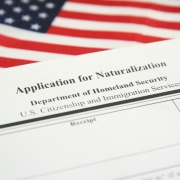The Devastating Legal Actions Donald Trump Could Take to Dismantle the U.S. Immigration System if Reelected
By Brian Figeroux, Esq. | Editorial Credit: Prashantrajsingh / shutterstock.com
If reelected, Donald Trump would have significant legal tools at his disposal to carry out his immigration agenda. Through executive orders, presidential proclamations, and legislative efforts, he could pursue mass deportations, revive the Muslim Ban, and terminate programs like DACA, TPS, and Parole in Place. However, these policies would face significant legal challenges, political opposition, and public backlash. Read more at www.askthelawyer.us. To read the complete analysis in our publication, click here, and on our civil rights blog, click here.
If reelected as president, Donald Trump could significantly alter U.S. immigration policies through legal actions, primarily relying on two broad avenues: executive orders and congressional legislation. His potential initiatives, such as mass deportations, reviving the Muslim Ban, and ending programs like Temporary Protected Status (TPS), Deferred Action for Childhood Arrivals (DACA), and Parole in Place, would involve a combination of executive authority and, where necessary, the cooperation of Congress. This analysis explores the legal mechanisms available to a future Trump administration, the challenges these policies may face, and their potential impacts.
Executive Orders and Presidential Proclamations
The presidency holds significant power to shape immigration policy through executive orders and proclamations. During his first term, Donald Trump frequently used these tools to bypass congressional gridlock, particularly regarding immigration. Should he return to office, we can expect a similar reliance on executive authority. Below are key areas where Trump could act unilaterally.
- Mass Deportations and ICE Raids
Trump has promised to conduct the largest mass deportation in American history, potentially targeting millions of undocumented immigrants. While this is a politically charged goal, it could be partially accomplished through executive orders and administrative changes.
- Expanding ICE Enforcement Priorities: Trump could direct Immigration and Customs Enforcement (ICE) to dramatically increase deportations by broadening the scope of enforcement priorities. Under the Obama administration, ICE focused on deporting immigrants with serious criminal records. Trump could revert to his previous policy of deporting anyone in the country without documentation, regardless of criminal history. This could involve hiring additional ICE officers, expanding detention centers, and increasing resources for immigration courts to expedite removal proceedings.
- Operation and Logistics of Mass Deportations: The legality of mass deportations depends on how they are carried out. While ICE has broad authority to enforce immigration laws, mass raids or deportations targeting large numbers of people simultaneously could face legal challenges, particularly on the grounds of due process rights and resource allocation. Lawsuits from civil rights organizations and immigrant advocacy groups would likely contest the constitutionality of these actions, arguing they violate Fourth and Fifth Amendment protections.
- Reviving the Muslim Ban
Trump could reinstate his controversial “Muslim Ban” through executive order, similar to the one he signed in 2017 that restricted travel from several predominantly Muslim countries. This policy was challenged in courts but was eventually upheld by the Supreme Court in a modified form.
- Legal Framework for a New Travel Ban: Trump would likely use national security as a justification, which falls within the president’s broad authority to regulate immigration. Under the Immigration and Nationality Act (INA) Section 212(f), the president has the power to suspend the entry of any class of aliens deemed detrimental to the interests of the United States. The Supreme Court ruling in Trump v. Hawaii (2018) affirmed this power, which Trump could leverage again.
- Potential Legal Challenges: Any attempt to reinstate the Muslim Ban would likely face immediate legal challenges. Civil rights groups and affected individuals would argue that the policy discriminates on the basis of religion, violating the First Amendment and Equal Protection Clause of the Constitution. However, if framed as a national security measure, it could once again withstand judicial scrutiny, especially given the precedent set by the Supreme Court.
- Ending TPS, DACA, and Parole in Place
Programs like TPS, DACA, and Parole in Place (PIP) are executive actions that protect specific groups of immigrants from deportation. Trump’s administration attempted to end both TPS and DACA during his first term but faced significant legal obstacles. If reelected, Trump could pursue their termination more aggressively.
- Temporary Protected Status (TPS): TPS provides temporary legal status to individuals from countries experiencing armed conflict, environmental disasters, or other extraordinary conditions. Trump sought to end TPS for nationals from countries like El Salvador, Honduras, Haiti, and Sudan. He could again direct the Department of Homeland Security (DHS) to terminate TPS designations for these countries, arguing that the conditions that justified the original designations no longer exist. Courts temporarily blocked his previous attempts, citing the need for further review and a lack of clear reasoning for ending the program.
- Deferred Action for Childhood Arrivals (DACA): DACA provides work permits and temporary deportation relief to individuals brought to the U.S. as children (often referred to as “Dreamers”). Trump’s attempt to end DACA was blocked by the Supreme Court in Department of Homeland Security v. Regents of the University of California (2020), which ruled that the administration’s termination of the program was “arbitrary and capricious” under the Administrative Procedure Act (APA). However, the ruling left the door open for the government to attempt to end the program with better justification. Trump could pursue this avenue by issuing a new order with a more legally robust rationale for ending DACA.
- Parole in Place (PIP): PIP allows certain undocumented family members of U.S. military personnel to remain in the U.S. without fear of deportation. This program was created by the executive branch and could be ended through executive action. Trump could direct DHS to rescind PIP, arguing that it undermines immigration enforcement.
Legislative Actions Through Congress
While executive orders can accomplish much, Trump’s more ambitious immigration goals would require legislative action. To enact sweeping changes to the immigration system, Trump would need to work with Congress, potentially utilizing his influence over a Republican-controlled Congress to pass legislation aligning with his objectives.
- Reforming the Immigration and Nationality Act (INA)
The INA is the primary body of law governing immigration to the United States. Trump could seek to amend the INA to restrict legal immigration, tighten asylum requirements, and enhance enforcement mechanisms.
- Reducing Legal Immigration: Trump could push for reductions in family-based immigration, diversity visas, and refugee admissions. His previous attempts at comprehensive immigration reform focused on merit-based immigration, which would prioritize immigrants with specific skills over those seeking to reunite with family members in the U.S. Amending the INA to shift toward merit-based immigration would require legislative approval and could face opposition from Democrats and some moderate Republicans.
- Tightening Asylum Laws: Trump could work with Congress to pass legislation that narrows eligibility for asylum. His administration previously attempted to restrict asylum by imposing higher bars for entry, such as the “Remain in Mexico” policy and agreements with Central American countries requiring asylum seekers to apply in the first safe country they enter. Legislation could codify these restrictions, making it harder for asylum seekers to enter the U.S. and remain while their claims are processed.
- Enhanced Border Security and Enforcement Funding: Trump could push for more funding for border wall construction, ICE, and Customs and Border Protection (CBP). Additional legislative measures could provide for more detention centers, expanded deportation capacities, and increased use of technology for border surveillance. These efforts would likely pass more easily through a Republican-controlled Congress.
- Terminating TPS and DACA Through Legislation
Rather than relying solely on executive actions, Trump could seek to terminate TPS and DACA through congressional legislation.
- Ending TPS: Trump could propose legislation to eliminate the TPS program altogether or severely restrict its application. This would prevent future administrations from designating new countries for TPS and ensure that current beneficiaries lose their protection once their status expires. However, such legislation would likely face significant opposition, especially from Democratic lawmakers and immigrant rights advocates.
- Ending DACA: If efforts to terminate DACA through executive action face continued legal challenges, Trump could push for legislation that definitively ends the program. This would involve repealing the underlying statutory authority for DACA and explicitly prohibiting future administrations from creating similar programs. The political feasibility of this strategy is uncertain, as there is bipartisan support for protecting Dreamers in some form.
Challenges and Obstacles to Trump’s Immigration Agenda
Despite the significant power the president holds over immigration policy, Trump’s agenda would face numerous legal, political, and practical challenges. Here are some key obstacles that could impede his efforts:
- Legal Challenges
Trump’s proposed policies, particularly mass deportations, the Muslim Ban, and the termination of TPS and DACA, would undoubtedly face legal challenges. Immigrant rights organizations, civil liberties groups, and state governments could file lawsuits arguing that these policies violate constitutional rights, statutory protections, or administrative procedures.
- Due Process and Equal Protection: Mass deportations and targeted immigration restrictions based on religion or nationality could be challenged on constitutional grounds, particularly under the Fifth Amendment’s due process protections and the Fourteenth Amendment’s Equal Protection Clause.
- Administrative Procedure Act (APA): Any attempt to terminate programs like DACA and TPS would need to comply with the APA, which requires agencies to provide a reasoned explanation for their actions. Failure to follow proper administrative procedures could lead courts to block these efforts, as they did during Trump’s first term.
- Congressional Gridlock
While Trump could take executive actions unilaterally, legislative changes would require cooperation from Congress. Even if Republicans control both chambers, immigration reform is a contentious issue that divides the party. Moderate Republicans may balk at Trump’s most extreme proposals, such as ending DACA or TPS, while Democrats would likely block any attempts to dismantle humanitarian protections.
- Public and Political Backlash
Trump’s immigration policies were a central issue during his first term, sparking widespread protests and backlash. Mass deportations, travel bans, and the termination of programs like DACA and TPS could reignite public opposition, potentially mobilizing voters and advocacy groups to resist these policies through legal, political, and grassroots efforts.
The Impact of Trump’s Immigration Agenda
If Trump were able to carry out his immigration agenda, the impact on millions of people would be profound. Mass deportations would disrupt families, communities, and businesses across the country, while restrictions on legal immigration would affect industries that rely on foreign labor. Terminating humanitarian programs like DACA and TPS would leave thousands vulnerable to deportation and create uncertainty for individuals who have lived in the U.S. for years, contributing to the economy and society.
- Economic Consequences: Removing large numbers of undocumented workers could have significant economic repercussions, particularly in industries like agriculture, construction, and hospitality. Additionally, restricting legal immigration could impact the tech sector, healthcare, and other industries that rely on skilled foreign workers.
- Humanitarian Impact: Ending programs like DACA and TPS would force thousands of people back to countries they may not have seen in decades, with potentially devastating consequences. Many DACA recipients and TPS holders have built lives in the U.S., and deporting them would separate families, disrupt communities, and strain the social fabric.
- International Relations: Trump’s immigration policies could strain relations with other countries, particularly those affected by travel bans or mass deportations. Countries in Central America, for example, could face increased instability if large numbers of deported individuals are returned to situations of violence and poverty.
Conclusion
If reelected, Donald Trump would have significant legal tools at his disposal to carry out his immigration agenda. Through executive orders, presidential proclamations, and legislative efforts, he could pursue mass deportations, revive the Muslim Ban, and terminate programs like DACA, TPS, and Parole in Place. However, these policies would face significant legal challenges, political opposition, and public backlash.
While the presidency holds considerable power over immigration, the ultimate success of Trump’s agenda would depend on a combination of legal maneuvering, congressional cooperation, and public support. Should he overcome these obstacles, the impact on the U.S. immigration system and millions of immigrants living in the U.S. would be far-reaching, with profound humanitarian, economic, and political consequences.












Leave a Reply
Want to join the discussion?Feel free to contribute!